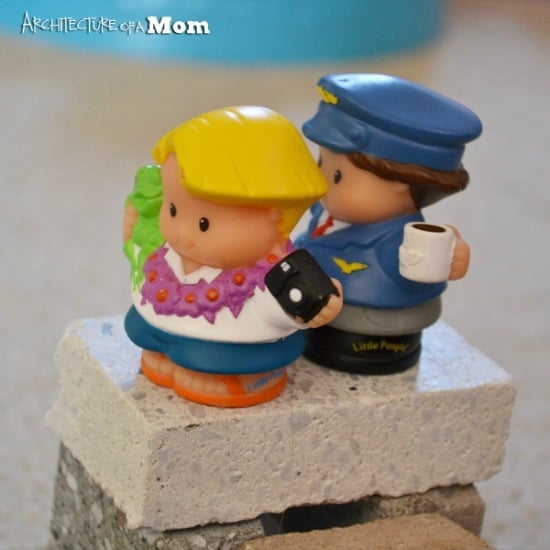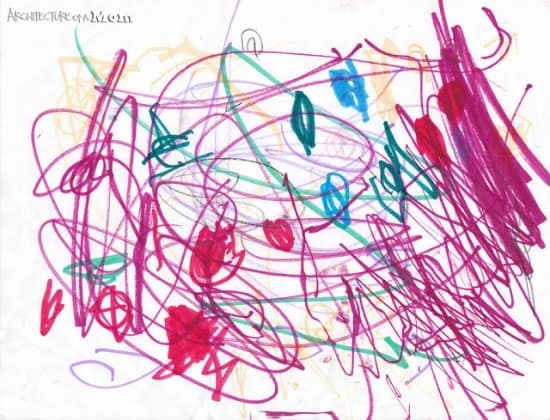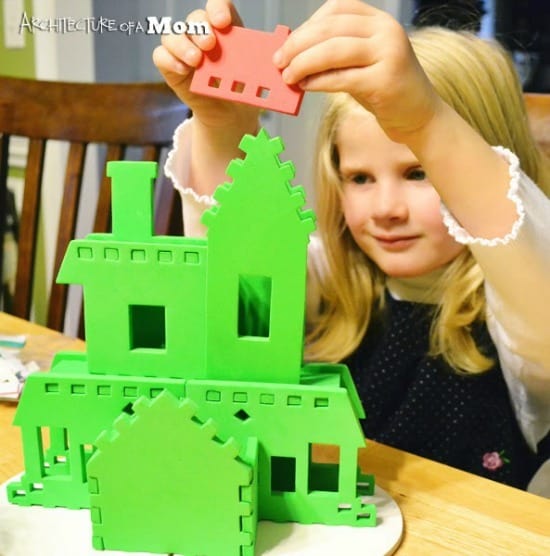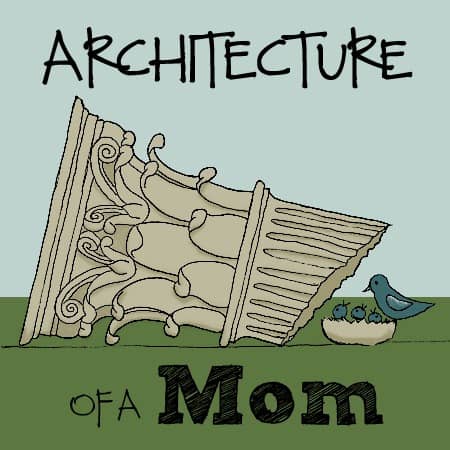I’ve been wanting to write a post about architecture for kids for a while, but something kept holding me back. Maybe it’s because I really don’t know much about architecture! So I decided to ask somebody who is quite knowledgeable about the subject to share her thoughts with us. So excited. Read on!
*****
Hi everybody! My name is Rachel, and I blog over at Architecture of a Mom, where I share craft and DIY projects, recipes, and my parenting adventures with 3 little girls ages 5, 2, and 2!
But when I’m not blogging, or crafting, or cooking, or having a blast with my family…I’m an architect. Yup, a real architect…so don’t think that I act like Mr. Brady from The Brady Bunch or Ted Mosley from How I Met Your Mother. It’s not an easy field to get into, with most programs starting very small and graduating an even smaller class. With that said, it’s also a very rewarding field with an amazing variety in what you can do with it! After all, how many people can say that they have a hand in designing permanent, beautiful structures?
So, do you have a toddler architect on your hands? Or do you want to nudge your middle schooler into become the next Frank Lloyd Wright? Jeanette has asked me to share with you ways to encourage an appreciation for architecture, and maybe even encourage the skills needed to become and architect. I think you’ll be surprised at how simple some of these ideas are. Here are just a few ways to encourage your budding architect:
Preschool/Elementary School Age Children:
Build a fort. Whether it’s out of pillows, snow, or scrap lumber, I haven’t met a kid who doesn’t enjoy making their own space. Defining a space = architecture at its very root.

Use building blocks. It really doesn’t matter if it’s wood blocks, or legos, megablocks, bristle blocks, or any other of the wide range of blocks available. In fact, it doesn’t even need to be real blocks, at all. My girls use concrete counter top samples as blocks outside (they also pretend they are sandwiches, pads of paper, and anything else that suits their fancy). Part of architecture is learning how to use new materials and using old materials in new ways.
Use blank paper. Coloring books have their place, but if you want your children to get really creative, hand them a blank piece of paper.

Give them a prompt….or don’t. See what they create! Then ask them to explain what they’ve drawn. Architecture is only partially drawing. On a daily basis, I have to describe and defend my creations to others verbally. Not everyone can interpret architectural drawings; my job as an architect is to convey my design to my boss and to my client in a way that they can understand. (So don’t feel bad if you don’t know what it is your preschooler drew—it will help them develop their language skills to describe it!)
Middle School/High School Children

Discuss proportions and scale. Does your older child get frustrated with math? Does he wonder who uses proportions? Architects use proportions all the time. Think how crazy it would be if I had to draw a building as big as it actually is. Instead, I use a special ruler called a scale, and draw every foot of the building much smaller, but in proportion. Want an illustration? Call a local architectural firm and ask if they can give you a floor plan that they are going to throw away. Chances are, they have something they can give you. Then have your child draw their room to scale (graph paper is a good tool in this task).
Use free computer programs to design spaces and buildings (and a whole lot of other things). I use both the free version of sketchup and the paid version in my job as an architect. This program allows you to draw in 3 dimensions and create some really amazing images. Not only is it fun, but it gets your kids thinking in 3 dimensions, which will help them from geometry to gym class!
All Ages
Learn about different styles of architecture. Do you know the difference between a Greek temple and a Roman one? How about a Gothic church and a Renaissance one? This is a great history exercise! Pop quiz: anybody know what order the column is in my blog button?
You can tie this study of architectural styles into the time period or country they are studying at school, or maybe introduce the indigenous architecture of the exchange student they met. Or, on a more basic level, page through a real estate book and look at the differences! What kind of style do you like? Why? Why do you think this people group designs this way? Once you understand the basic elements of each style, play architectural Pictionary, where each team is trying to guess the style architecture you’re drawing.
Draw a floor plan of a playhouse in sidewalk chalk (outside) or painter’s tape (inside). This introduces the idea of a plan, and creates a different kind of space. This can be a simple rectangle, or you can add plan elements (furniture, plants, etc). Even if your kids don’t go into the design industry, this is a good life tool to have when they are trying to envision if a piece of furniture will fit in their house! Ask your child to draw their dream house, castle, or super hero hideout.Then have them write (or dictate if they are younger) a description of the space. Build a bird house, gingerbread house, dollhouse or model together!

There are plenty of sets that require no glue or shoot for the moon with a complex set (just make sure you stay within your child’s skill level!). This is another activity that helps your child think in 3 dimensions, understand scale, and learn good construction practicesLet your child help with light construction projects around the house. My five year old helps me sand. I will let her use a hammer. A comfort level with the tools of construction will only help them later in life, whether they become an architect…or a teacher, doctor, or bus driver.

What do you think? What kind of skills do you thing you need to become an architect? Are you already encouraging your child to think like an architect, and you didn’t even know it?
Thanks, Jeanette, for letting me share some of my knowledge about architecture with your readers. If you would like to come check out Architecture of a Mom and find out just what my daughter was helping me make, I would love it if you came by and visit me at Architecture of a Mom or at these social media locations:
Have a great day!

Comments
0 comments






Great guest post, I love architecture, never thought to introduce the idea at such a young age. Heading to follow!
Isn’t this great? I’m so pleased to have had Rachel post here, and I will be using some of her ideas with my kids!
I also think that talking about buildings is a good way to introduce architecture to kids. What do they like or dislike about a building. What makes it special. Is the architect well known? We are lucky because we have some pretty amazing buildings in the Boston area.
Great idea- I think just simple conversations about buildings will at least make kids aware of them as more than shelter.
Corinthian Order (I hope!) Great blog. Just the sort of thing I like writing about too.
Corinthian! I think you’re the big winner! Of…the satisfaction of knowing your columns….. love your blog; thanks for commenting!
Thanks for the great kid friendly intro to architecture and hands on ideas!
My dad is a builder and as a kid I used to love borrowing his design templates and make my own plans. My kids love creating forts and playing with blocks never goes out of style. They have even played around with Sketch Up.
I am an industrial designer and can relate to the competitiveness. I guess it is because creative fields are so desirable. You have to work very hard!
I love that you gravitated to your dad’s design templates when you were a kid! I’ll have to interview you for a future post…
Hi Jeannette and Rachel
Thanks for a great primer. I love architecture, but have never seriously taught it.
I love the idea of the castle and super hero hideout floor plans. Dream house would work too! I need to see if there is a free sketch up app for iPad as our school will be 1:1 iPad this year. Thanks again for sharing your ideas!
Oh, lucky kids with those iPads! I think architecture is such a great subject for kids, because it’s all over the place out in the open for everyone to see, and they do gravitate to making forts and houses for toys. It’s a great opportunity to talk architecture while they’re playing!